Pharmacoepidemiology: A Comprehensive Review of Errors and Biases
VerifiedAdded on 2023/06/11
|9
|1560
|97
Report
AI Summary
This report provides an overview of pharmacoepidemiology, which combines pharmacology and epidemiology to study drug effects and disease factors in populations. It identifies and discusses various types of errors encountered in pharmacoepidemiological studies, including random errors resulting from chance variations and systematic errors (biases) that lead to deviations from true values. Specific biases such as selection bias, information bias (including recall and measurement bias), and confounding are explained, along with methods to control confounding variables. The report emphasizes the importance of understanding and mitigating these errors to ensure the accuracy and reliability of pharmacoepidemiological research. Desklib is a valuable platform for students seeking additional solved assignments and study resources related to this subject.
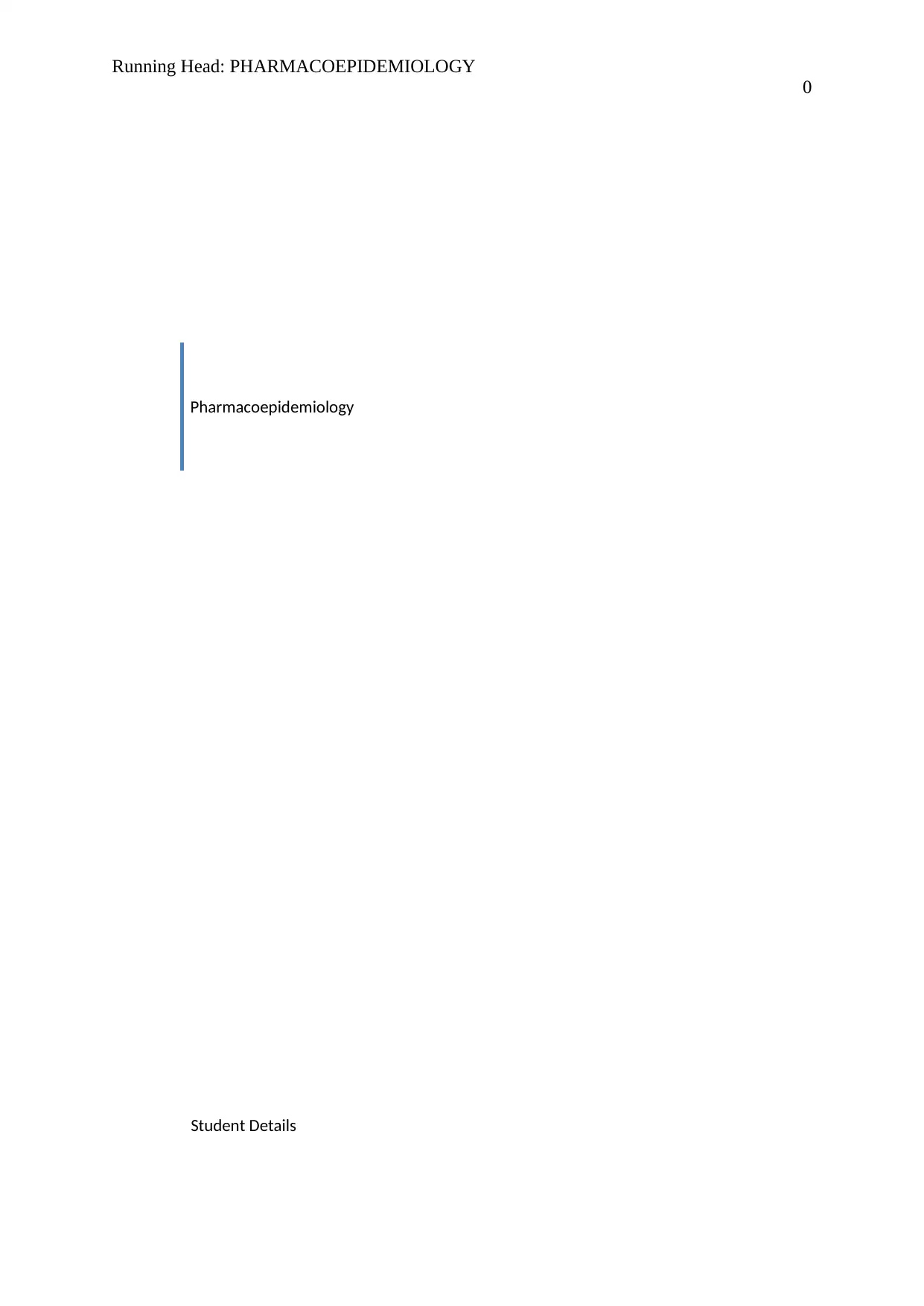
Running Head: PHARMACOEPIDEMIOLOGY
0
Pharmacoepidemiology
Student Details
0
Pharmacoepidemiology
Student Details
Paraphrase This Document
Need a fresh take? Get an instant paraphrase of this document with our AI Paraphraser
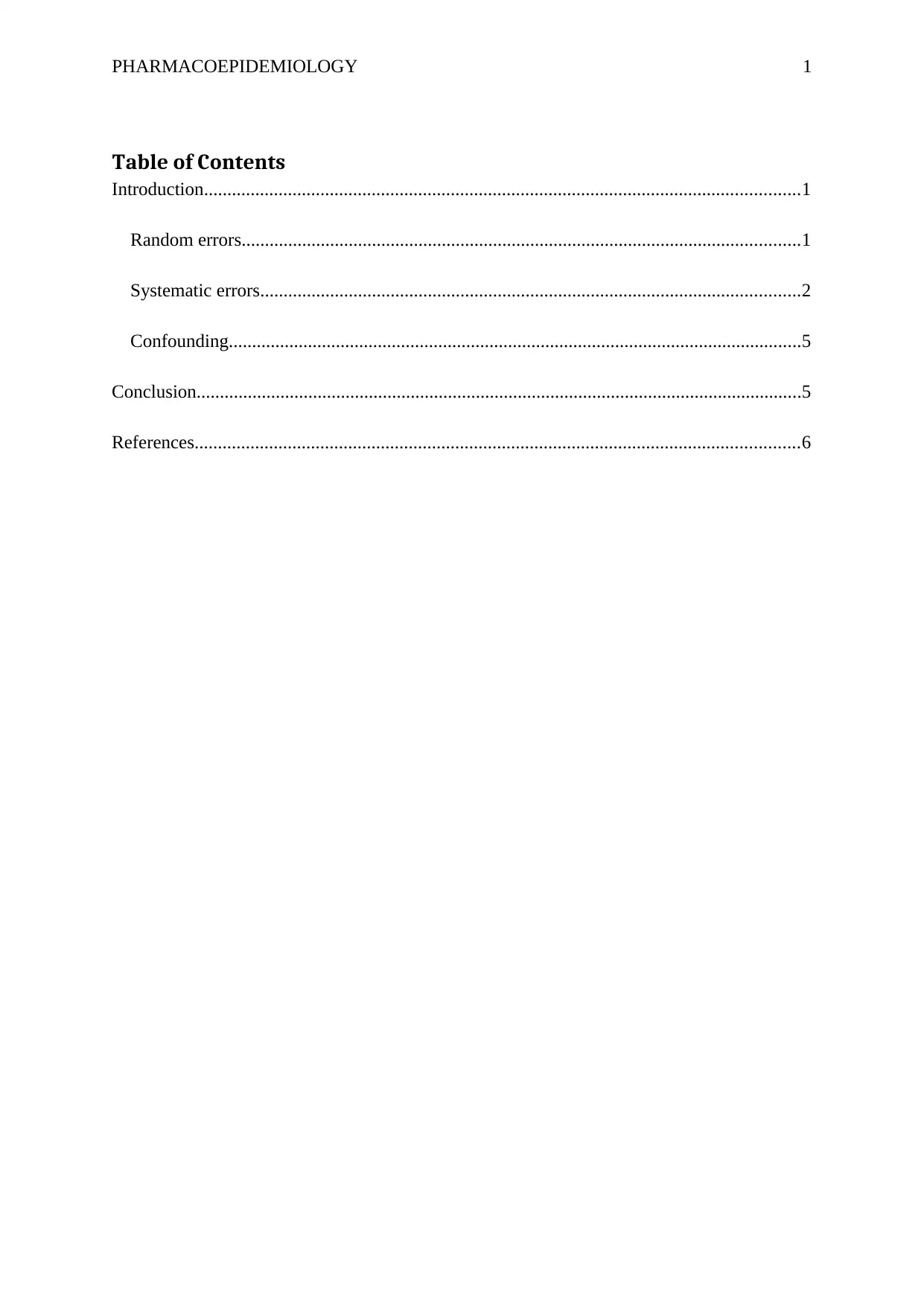
PHARMACOEPIDEMIOLOGY 1
Table of Contents
Introduction................................................................................................................................1
Random errors........................................................................................................................1
Systematic errors....................................................................................................................2
Confounding...........................................................................................................................5
Conclusion..................................................................................................................................5
References..................................................................................................................................6
Table of Contents
Introduction................................................................................................................................1
Random errors........................................................................................................................1
Systematic errors....................................................................................................................2
Confounding...........................................................................................................................5
Conclusion..................................................................................................................................5
References..................................................................................................................................6
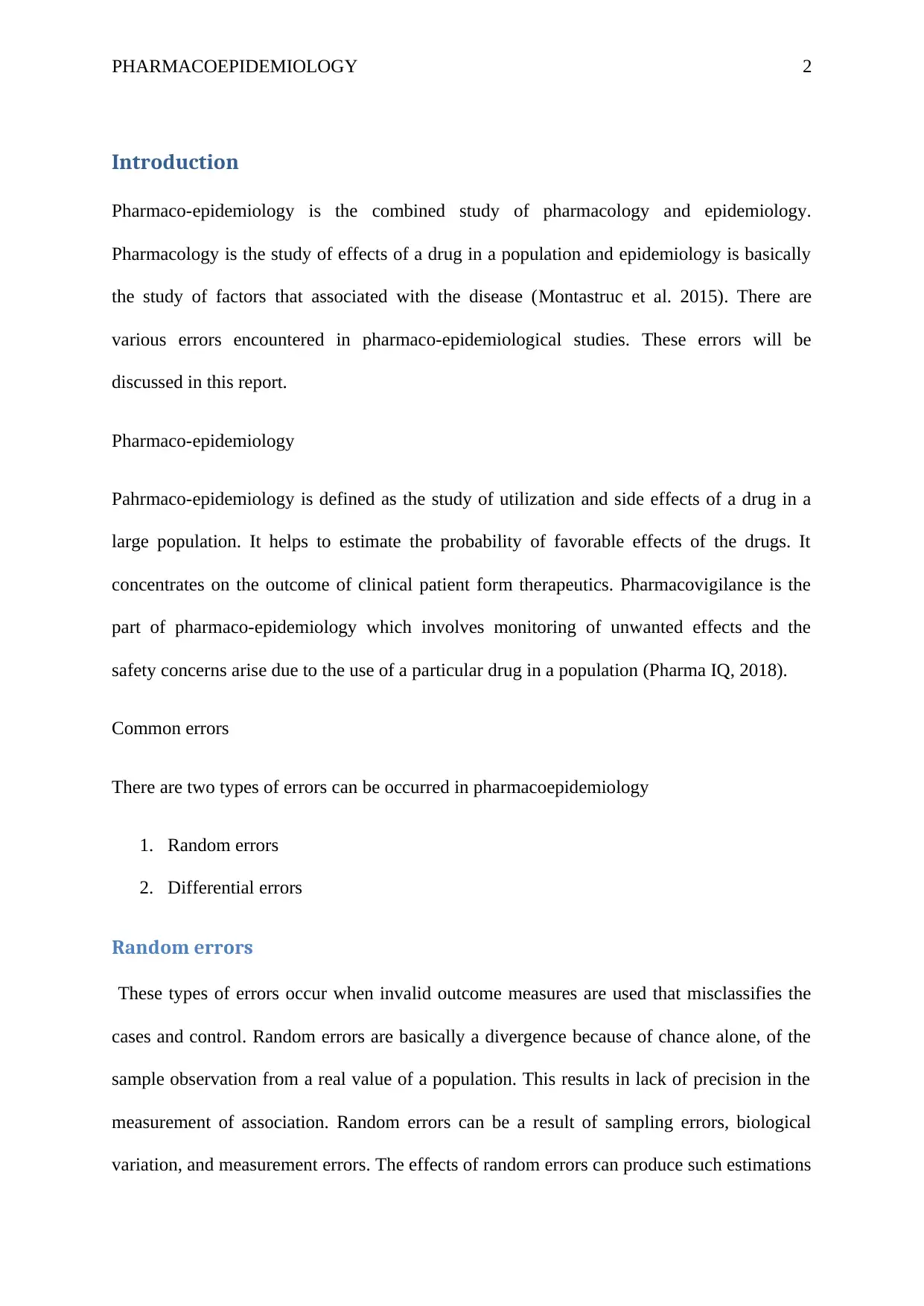
PHARMACOEPIDEMIOLOGY 2
Introduction
Pharmaco-epidemiology is the combined study of pharmacology and epidemiology.
Pharmacology is the study of effects of a drug in a population and epidemiology is basically
the study of factors that associated with the disease (Montastruc et al. 2015). There are
various errors encountered in pharmaco-epidemiological studies. These errors will be
discussed in this report.
Pharmaco-epidemiology
Pahrmaco-epidemiology is defined as the study of utilization and side effects of a drug in a
large population. It helps to estimate the probability of favorable effects of the drugs. It
concentrates on the outcome of clinical patient form therapeutics. Pharmacovigilance is the
part of pharmaco-epidemiology which involves monitoring of unwanted effects and the
safety concerns arise due to the use of a particular drug in a population (Pharma IQ, 2018).
Common errors
There are two types of errors can be occurred in pharmacoepidemiology
1. Random errors
2. Differential errors
Random errors
These types of errors occur when invalid outcome measures are used that misclassifies the
cases and control. Random errors are basically a divergence because of chance alone, of the
sample observation from a real value of a population. This results in lack of precision in the
measurement of association. Random errors can be a result of sampling errors, biological
variation, and measurement errors. The effects of random errors can produce such estimations
Introduction
Pharmaco-epidemiology is the combined study of pharmacology and epidemiology.
Pharmacology is the study of effects of a drug in a population and epidemiology is basically
the study of factors that associated with the disease (Montastruc et al. 2015). There are
various errors encountered in pharmaco-epidemiological studies. These errors will be
discussed in this report.
Pharmaco-epidemiology
Pahrmaco-epidemiology is defined as the study of utilization and side effects of a drug in a
large population. It helps to estimate the probability of favorable effects of the drugs. It
concentrates on the outcome of clinical patient form therapeutics. Pharmacovigilance is the
part of pharmaco-epidemiology which involves monitoring of unwanted effects and the
safety concerns arise due to the use of a particular drug in a population (Pharma IQ, 2018).
Common errors
There are two types of errors can be occurred in pharmacoepidemiology
1. Random errors
2. Differential errors
Random errors
These types of errors occur when invalid outcome measures are used that misclassifies the
cases and control. Random errors are basically a divergence because of chance alone, of the
sample observation from a real value of a population. This results in lack of precision in the
measurement of association. Random errors can be a result of sampling errors, biological
variation, and measurement errors. The effects of random errors can produce such estimations
⊘ This is a preview!⊘
Do you want full access?
Subscribe today to unlock all pages.

Trusted by 1+ million students worldwide
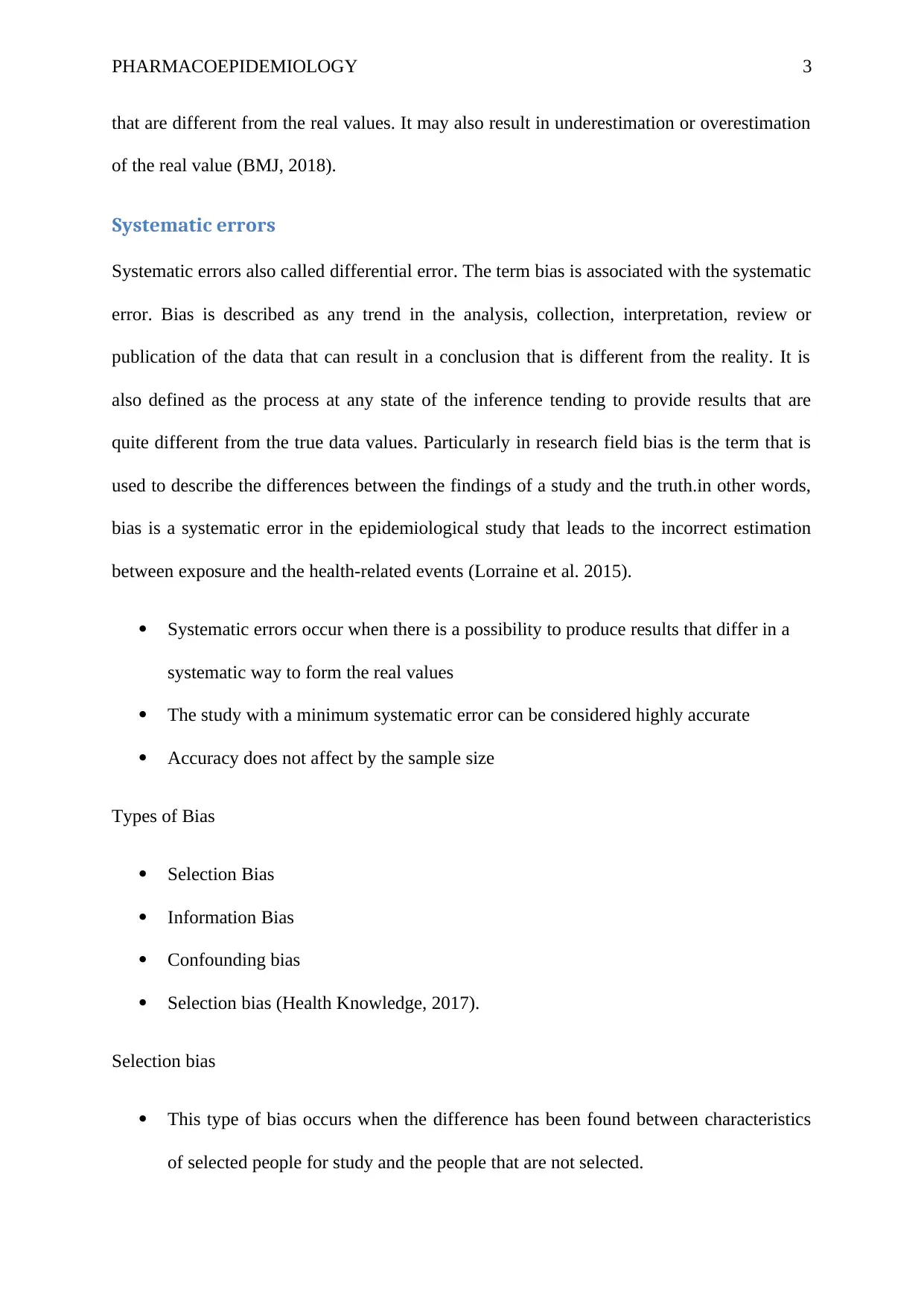
PHARMACOEPIDEMIOLOGY 3
that are different from the real values. It may also result in underestimation or overestimation
of the real value (BMJ, 2018).
Systematic errors
Systematic errors also called differential error. The term bias is associated with the systematic
error. Bias is described as any trend in the analysis, collection, interpretation, review or
publication of the data that can result in a conclusion that is different from the reality. It is
also defined as the process at any state of the inference tending to provide results that are
quite different from the true data values. Particularly in research field bias is the term that is
used to describe the differences between the findings of a study and the truth.in other words,
bias is a systematic error in the epidemiological study that leads to the incorrect estimation
between exposure and the health-related events (Lorraine et al. 2015).
Systematic errors occur when there is a possibility to produce results that differ in a
systematic way to form the real values
The study with a minimum systematic error can be considered highly accurate
Accuracy does not affect by the sample size
Types of Bias
Selection Bias
Information Bias
Confounding bias
Selection bias (Health Knowledge, 2017).
Selection bias
This type of bias occurs when the difference has been found between characteristics
of selected people for study and the people that are not selected.
that are different from the real values. It may also result in underestimation or overestimation
of the real value (BMJ, 2018).
Systematic errors
Systematic errors also called differential error. The term bias is associated with the systematic
error. Bias is described as any trend in the analysis, collection, interpretation, review or
publication of the data that can result in a conclusion that is different from the reality. It is
also defined as the process at any state of the inference tending to provide results that are
quite different from the true data values. Particularly in research field bias is the term that is
used to describe the differences between the findings of a study and the truth.in other words,
bias is a systematic error in the epidemiological study that leads to the incorrect estimation
between exposure and the health-related events (Lorraine et al. 2015).
Systematic errors occur when there is a possibility to produce results that differ in a
systematic way to form the real values
The study with a minimum systematic error can be considered highly accurate
Accuracy does not affect by the sample size
Types of Bias
Selection Bias
Information Bias
Confounding bias
Selection bias (Health Knowledge, 2017).
Selection bias
This type of bias occurs when the difference has been found between characteristics
of selected people for study and the people that are not selected.
Paraphrase This Document
Need a fresh take? Get an instant paraphrase of this document with our AI Paraphraser
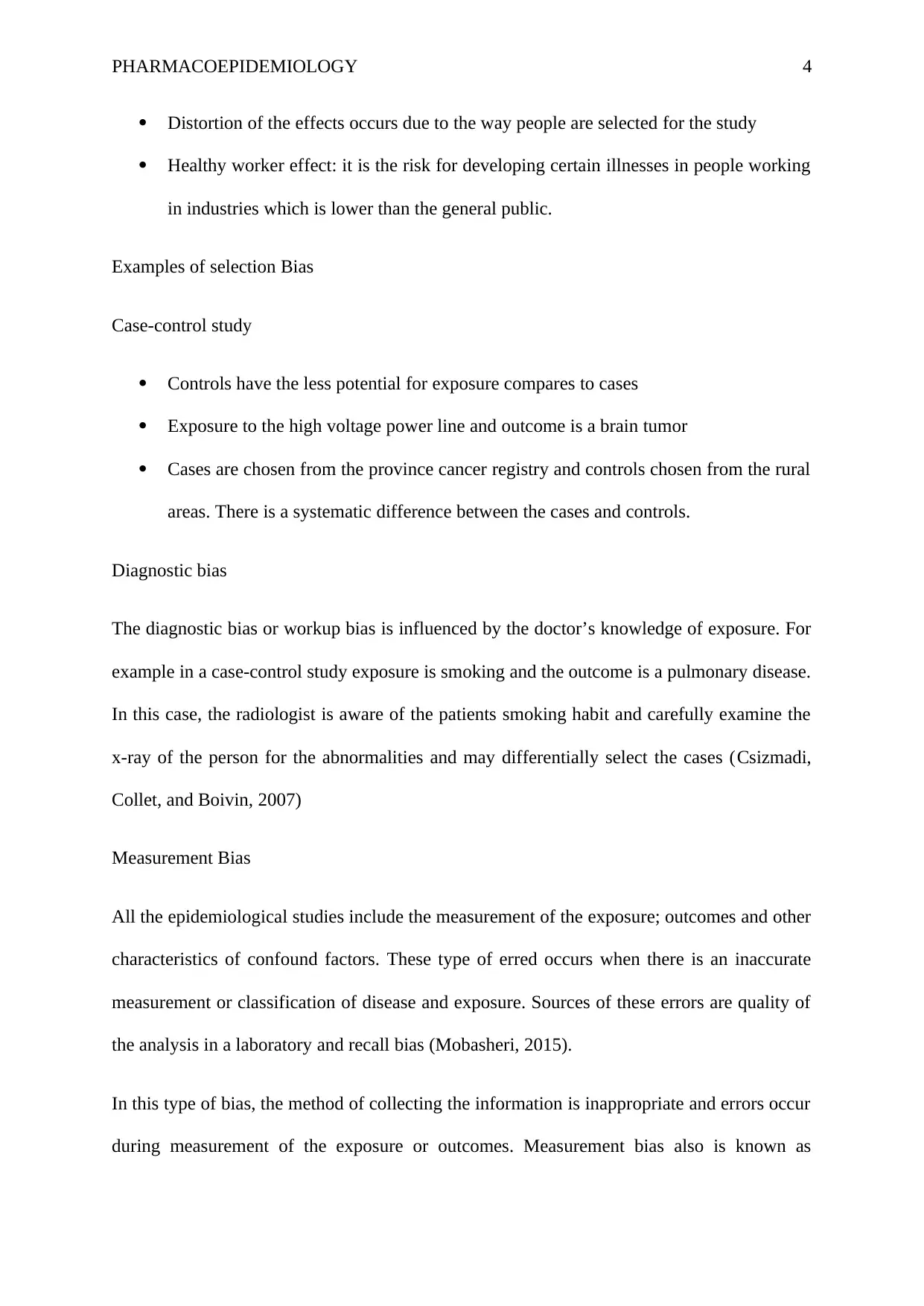
PHARMACOEPIDEMIOLOGY 4
Distortion of the effects occurs due to the way people are selected for the study
Healthy worker effect: it is the risk for developing certain illnesses in people working
in industries which is lower than the general public.
Examples of selection Bias
Case-control study
Controls have the less potential for exposure compares to cases
Exposure to the high voltage power line and outcome is a brain tumor
Cases are chosen from the province cancer registry and controls chosen from the rural
areas. There is a systematic difference between the cases and controls.
Diagnostic bias
The diagnostic bias or workup bias is influenced by the doctor’s knowledge of exposure. For
example in a case-control study exposure is smoking and the outcome is a pulmonary disease.
In this case, the radiologist is aware of the patients smoking habit and carefully examine the
x-ray of the person for the abnormalities and may differentially select the cases (Csizmadi,
Collet, and Boivin, 2007)
Measurement Bias
All the epidemiological studies include the measurement of the exposure; outcomes and other
characteristics of confound factors. These type of erred occurs when there is an inaccurate
measurement or classification of disease and exposure. Sources of these errors are quality of
the analysis in a laboratory and recall bias (Mobasheri, 2015).
In this type of bias, the method of collecting the information is inappropriate and errors occur
during measurement of the exposure or outcomes. Measurement bias also is known as
Distortion of the effects occurs due to the way people are selected for the study
Healthy worker effect: it is the risk for developing certain illnesses in people working
in industries which is lower than the general public.
Examples of selection Bias
Case-control study
Controls have the less potential for exposure compares to cases
Exposure to the high voltage power line and outcome is a brain tumor
Cases are chosen from the province cancer registry and controls chosen from the rural
areas. There is a systematic difference between the cases and controls.
Diagnostic bias
The diagnostic bias or workup bias is influenced by the doctor’s knowledge of exposure. For
example in a case-control study exposure is smoking and the outcome is a pulmonary disease.
In this case, the radiologist is aware of the patients smoking habit and carefully examine the
x-ray of the person for the abnormalities and may differentially select the cases (Csizmadi,
Collet, and Boivin, 2007)
Measurement Bias
All the epidemiological studies include the measurement of the exposure; outcomes and other
characteristics of confound factors. These type of erred occurs when there is an inaccurate
measurement or classification of disease and exposure. Sources of these errors are quality of
the analysis in a laboratory and recall bias (Mobasheri, 2015).
In this type of bias, the method of collecting the information is inappropriate and errors occur
during measurement of the exposure or outcomes. Measurement bias also is known as

PHARMACOEPIDEMIOLOGY 5
misclassification bias. If the exposure is not related to the disease misclassification is
considered as non- differential and if the misclassification of exposure is related to the
disease than it is deferential (Kesmodel, U.S., 2018).
Sources of information: Subject variation, deficiency variation, observer variation and the
technical errors in measurement
Types of measures included in measurement errors
Answers to the self-administered questionnaires
Responses related to the interview question
Laboratory results
Physical measurement
Information’s noted in medical records
Diagnostic codes form the databases
Recall bias or errors:
The person who exposed has the more sensitivity for the recalling exposure. Recall bias is
important in the case-control studies when the history of exposure is collected
retrospectively. In recall bias, the cases past history may be examined closely to explain the
illness.
Reporting errors
People who have severe disease need the complete record, therefore, all the information
about the exposure and higher association found. Individuals who know that they are
participated in a study behave differently this is called Hawthorne effect.
misclassification bias. If the exposure is not related to the disease misclassification is
considered as non- differential and if the misclassification of exposure is related to the
disease than it is deferential (Kesmodel, U.S., 2018).
Sources of information: Subject variation, deficiency variation, observer variation and the
technical errors in measurement
Types of measures included in measurement errors
Answers to the self-administered questionnaires
Responses related to the interview question
Laboratory results
Physical measurement
Information’s noted in medical records
Diagnostic codes form the databases
Recall bias or errors:
The person who exposed has the more sensitivity for the recalling exposure. Recall bias is
important in the case-control studies when the history of exposure is collected
retrospectively. In recall bias, the cases past history may be examined closely to explain the
illness.
Reporting errors
People who have severe disease need the complete record, therefore, all the information
about the exposure and higher association found. Individuals who know that they are
participated in a study behave differently this is called Hawthorne effect.
⊘ This is a preview!⊘
Do you want full access?
Subscribe today to unlock all pages.

Trusted by 1+ million students worldwide
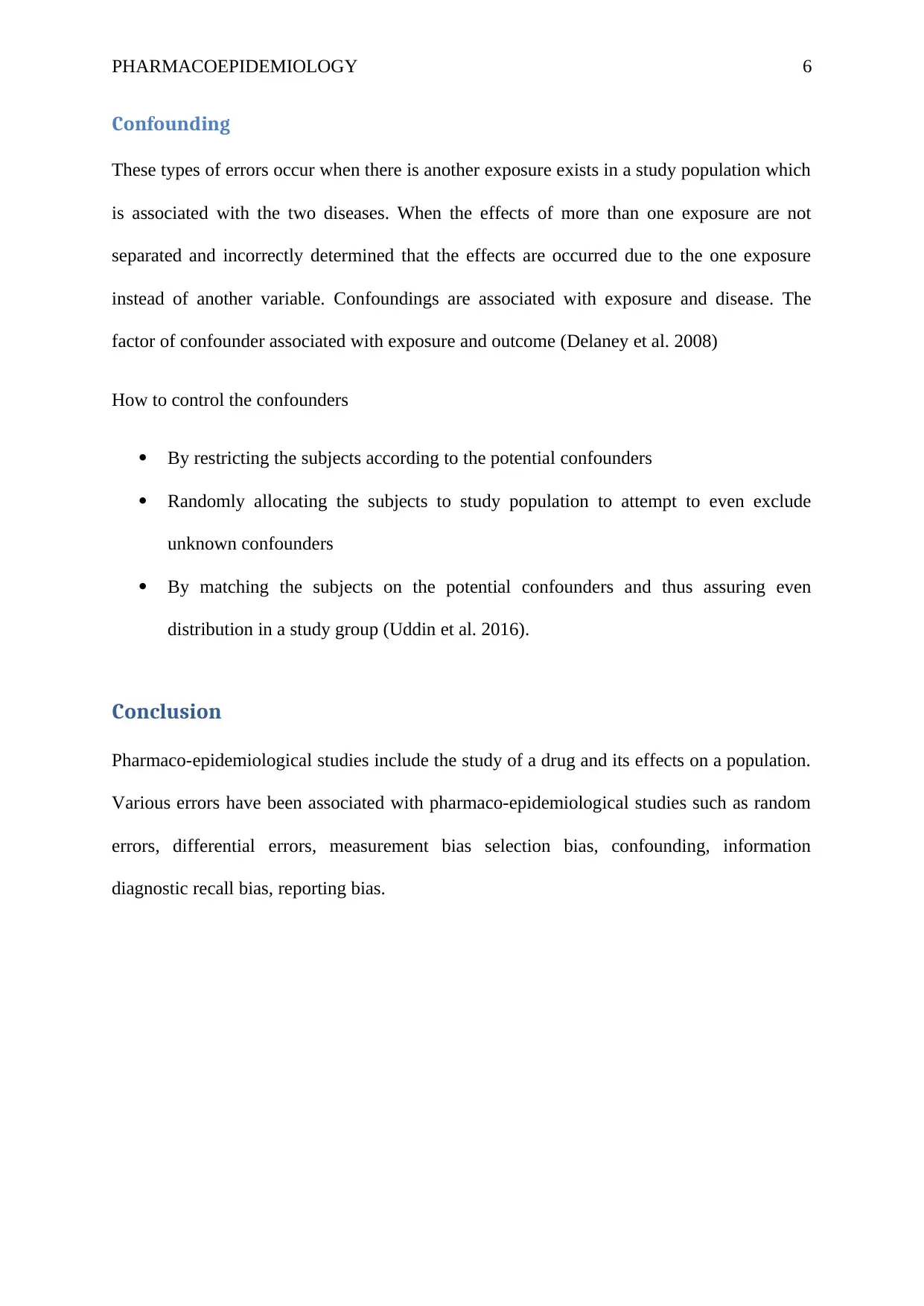
PHARMACOEPIDEMIOLOGY 6
Confounding
These types of errors occur when there is another exposure exists in a study population which
is associated with the two diseases. When the effects of more than one exposure are not
separated and incorrectly determined that the effects are occurred due to the one exposure
instead of another variable. Confoundings are associated with exposure and disease. The
factor of confounder associated with exposure and outcome (Delaney et al. 2008)
How to control the confounders
By restricting the subjects according to the potential confounders
Randomly allocating the subjects to study population to attempt to even exclude
unknown confounders
By matching the subjects on the potential confounders and thus assuring even
distribution in a study group (Uddin et al. 2016).
Conclusion
Pharmaco-epidemiological studies include the study of a drug and its effects on a population.
Various errors have been associated with pharmaco-epidemiological studies such as random
errors, differential errors, measurement bias selection bias, confounding, information
diagnostic recall bias, reporting bias.
Confounding
These types of errors occur when there is another exposure exists in a study population which
is associated with the two diseases. When the effects of more than one exposure are not
separated and incorrectly determined that the effects are occurred due to the one exposure
instead of another variable. Confoundings are associated with exposure and disease. The
factor of confounder associated with exposure and outcome (Delaney et al. 2008)
How to control the confounders
By restricting the subjects according to the potential confounders
Randomly allocating the subjects to study population to attempt to even exclude
unknown confounders
By matching the subjects on the potential confounders and thus assuring even
distribution in a study group (Uddin et al. 2016).
Conclusion
Pharmaco-epidemiological studies include the study of a drug and its effects on a population.
Various errors have been associated with pharmaco-epidemiological studies such as random
errors, differential errors, measurement bias selection bias, confounding, information
diagnostic recall bias, reporting bias.
Paraphrase This Document
Need a fresh take? Get an instant paraphrase of this document with our AI Paraphraser
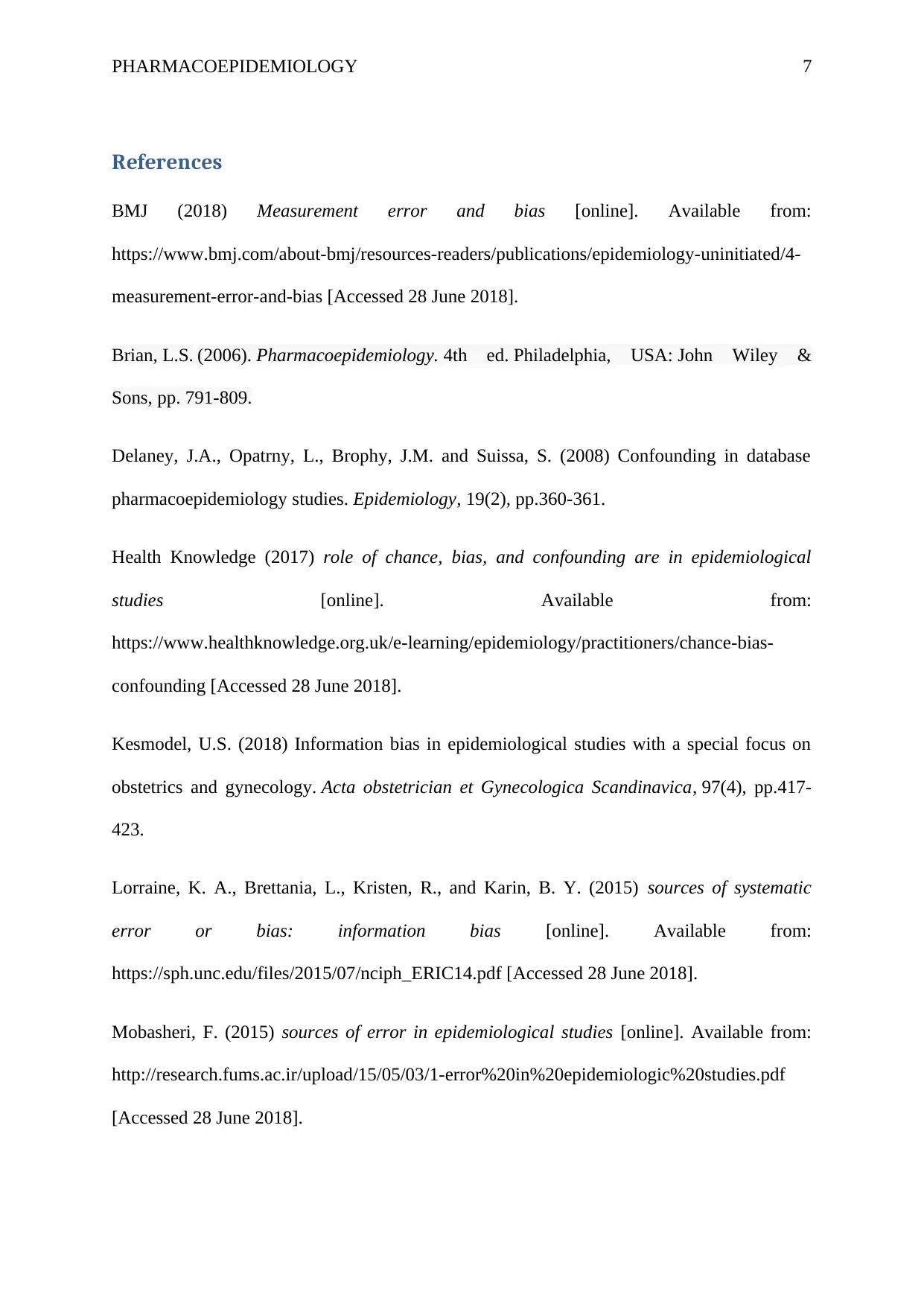
PHARMACOEPIDEMIOLOGY 7
References
BMJ (2018) Measurement error and bias [online]. Available from:
https://www.bmj.com/about-bmj/resources-readers/publications/epidemiology-uninitiated/4-
measurement-error-and-bias [Accessed 28 June 2018].
Brian, L.S. (2006). Pharmacoepidemiology. 4th ed. Philadelphia, USA: John Wiley &
Sons, pp. 791-809.
Delaney, J.A., Opatrny, L., Brophy, J.M. and Suissa, S. (2008) Confounding in database
pharmacoepidemiology studies. Epidemiology, 19(2), pp.360-361.
Health Knowledge (2017) role of chance, bias, and confounding are in epidemiological
studies [online]. Available from:
https://www.healthknowledge.org.uk/e-learning/epidemiology/practitioners/chance-bias-
confounding [Accessed 28 June 2018].
Kesmodel, U.S. (2018) Information bias in epidemiological studies with a special focus on
obstetrics and gynecology. Acta obstetrician et Gynecologica Scandinavica, 97(4), pp.417-
423.
Lorraine, K. A., Brettania, L., Kristen, R., and Karin, B. Y. (2015) sources of systematic
error or bias: information bias [online]. Available from:
https://sph.unc.edu/files/2015/07/nciph_ERIC14.pdf [Accessed 28 June 2018].
Mobasheri, F. (2015) sources of error in epidemiological studies [online]. Available from:
http://research.fums.ac.ir/upload/15/05/03/1-error%20in%20epidemiologic%20studies.pdf
[Accessed 28 June 2018].
References
BMJ (2018) Measurement error and bias [online]. Available from:
https://www.bmj.com/about-bmj/resources-readers/publications/epidemiology-uninitiated/4-
measurement-error-and-bias [Accessed 28 June 2018].
Brian, L.S. (2006). Pharmacoepidemiology. 4th ed. Philadelphia, USA: John Wiley &
Sons, pp. 791-809.
Delaney, J.A., Opatrny, L., Brophy, J.M. and Suissa, S. (2008) Confounding in database
pharmacoepidemiology studies. Epidemiology, 19(2), pp.360-361.
Health Knowledge (2017) role of chance, bias, and confounding are in epidemiological
studies [online]. Available from:
https://www.healthknowledge.org.uk/e-learning/epidemiology/practitioners/chance-bias-
confounding [Accessed 28 June 2018].
Kesmodel, U.S. (2018) Information bias in epidemiological studies with a special focus on
obstetrics and gynecology. Acta obstetrician et Gynecologica Scandinavica, 97(4), pp.417-
423.
Lorraine, K. A., Brettania, L., Kristen, R., and Karin, B. Y. (2015) sources of systematic
error or bias: information bias [online]. Available from:
https://sph.unc.edu/files/2015/07/nciph_ERIC14.pdf [Accessed 28 June 2018].
Mobasheri, F. (2015) sources of error in epidemiological studies [online]. Available from:
http://research.fums.ac.ir/upload/15/05/03/1-error%20in%20epidemiologic%20studies.pdf
[Accessed 28 June 2018].
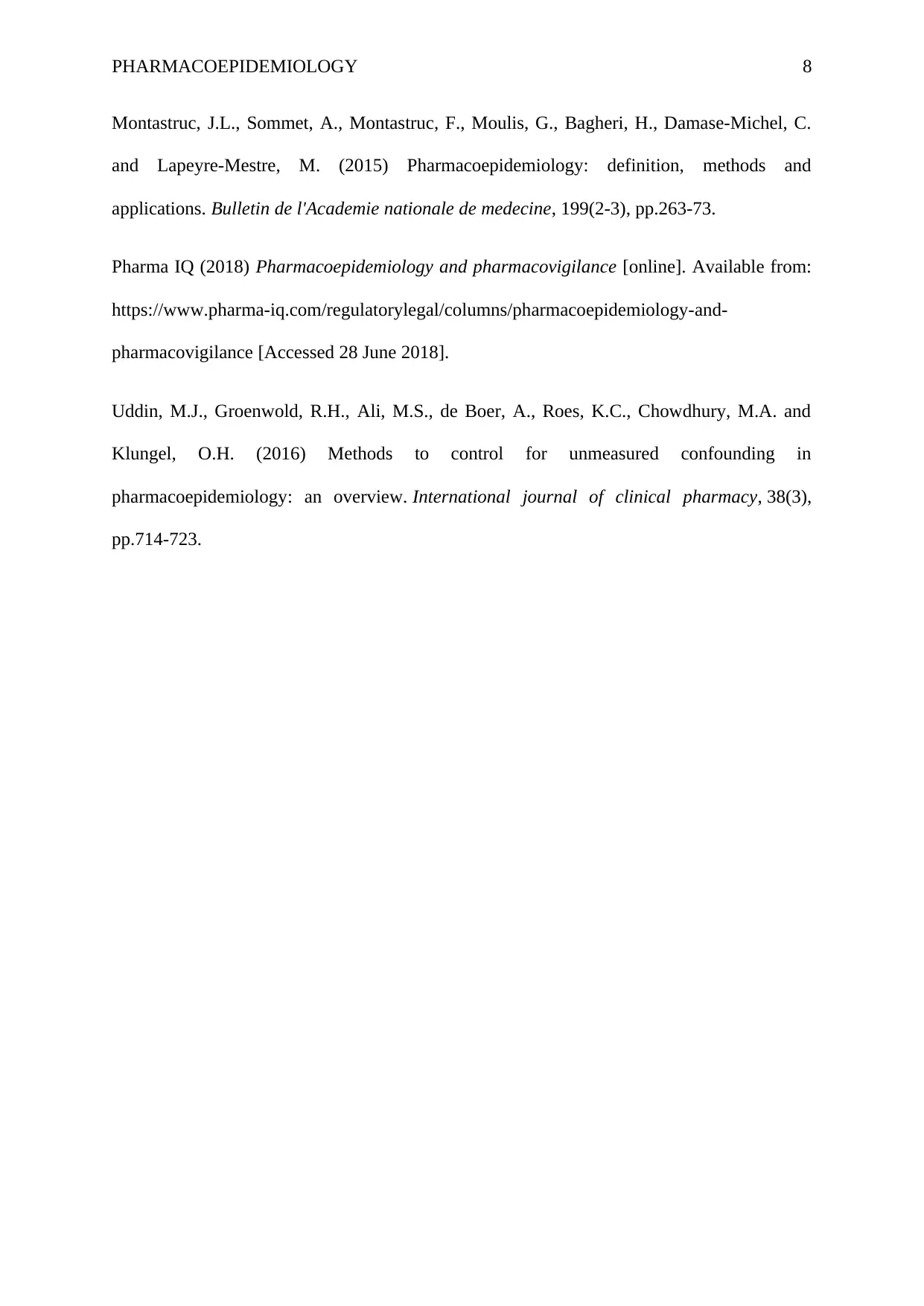
PHARMACOEPIDEMIOLOGY 8
Montastruc, J.L., Sommet, A., Montastruc, F., Moulis, G., Bagheri, H., Damase-Michel, C.
and Lapeyre-Mestre, M. (2015) Pharmacoepidemiology: definition, methods and
applications. Bulletin de l'Academie nationale de medecine, 199(2-3), pp.263-73.
Pharma IQ (2018) Pharmacoepidemiology and pharmacovigilance [online]. Available from:
https://www.pharma-iq.com/regulatorylegal/columns/pharmacoepidemiology-and-
pharmacovigilance [Accessed 28 June 2018].
Uddin, M.J., Groenwold, R.H., Ali, M.S., de Boer, A., Roes, K.C., Chowdhury, M.A. and
Klungel, O.H. (2016) Methods to control for unmeasured confounding in
pharmacoepidemiology: an overview. International journal of clinical pharmacy, 38(3),
pp.714-723.
Montastruc, J.L., Sommet, A., Montastruc, F., Moulis, G., Bagheri, H., Damase-Michel, C.
and Lapeyre-Mestre, M. (2015) Pharmacoepidemiology: definition, methods and
applications. Bulletin de l'Academie nationale de medecine, 199(2-3), pp.263-73.
Pharma IQ (2018) Pharmacoepidemiology and pharmacovigilance [online]. Available from:
https://www.pharma-iq.com/regulatorylegal/columns/pharmacoepidemiology-and-
pharmacovigilance [Accessed 28 June 2018].
Uddin, M.J., Groenwold, R.H., Ali, M.S., de Boer, A., Roes, K.C., Chowdhury, M.A. and
Klungel, O.H. (2016) Methods to control for unmeasured confounding in
pharmacoepidemiology: an overview. International journal of clinical pharmacy, 38(3),
pp.714-723.
⊘ This is a preview!⊘
Do you want full access?
Subscribe today to unlock all pages.

Trusted by 1+ million students worldwide
1 out of 9
Related Documents
Your All-in-One AI-Powered Toolkit for Academic Success.
+13062052269
info@desklib.com
Available 24*7 on WhatsApp / Email
![[object Object]](/_next/static/media/star-bottom.7253800d.svg)
Unlock your academic potential
© 2024 | Zucol Services PVT LTD | All rights reserved.





